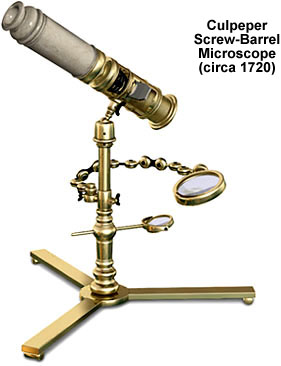Culpeper Screw-Barrel Microscope
Edmund Culpeper was an apprentice of famous London scientific instrument maker Walter Hayes during the late 1600s to the early 1700s. Culpeper made this early compound microscope in or around 1720, which is engraved "Culpeper Fecit".

The microscope has a brass tripod foot with long legs for extra support. The burned brass pillar has a both a concave mirror and a condenser lens mounted through a knuckle-jointed arm. The condenser is styled after the popular Bonanni design, and has a steel spring, two brass plates and a leather pad to hold a slider or glass tube for observation. The body, which is adapted to the pillar with a socket-ball joint, has a screw-barrel made of a threaded screw and hollow sleeve, and the compound portion is made of ivory with a single eye lens fashioned inside a carved eye cup. There were several objectives designed for this microscope, as well as a Liberkuhn lens that all fit into the screw-barrel body.
BACK TO EIGHTEENTH CENTURY MICROSCOPES
